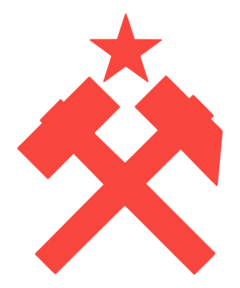User:Lobster/Sandbox 4: Difference between revisions
No edit summary |
No edit summary |
||
| Line 62: | Line 62: | ||
| membership_year = | | membership_year = | ||
| membership = 2,551,985 | | membership = 2,551,985 | ||
| ideology = {{wp|Democratic socialism}}<br>{{wp|Bevanism|State Socialism}}<br>{{wp|Cosmopolitanism}}<br>{{wp|Proletarian internationalism|Internationalism}}<br>[[Penumbrism]] (Right- | | ideology = {{wp|Democratic socialism}}<br>{{wp|Bevanism|State Socialism}}<br>{{wp|Cosmopolitanism}}<br>{{wp|Proletarian internationalism|Internationalism}}<br>[[Penumbrism]] (Right-wing)<br>[[Ilbonese Socialism]] (Left-wing) | ||
| position = {{wp|Centre-left politics|Center Left}} | | position = {{wp|Centre-left politics|Center Left}} | ||
| religion = | | religion = | ||
| Line 106: | Line 106: | ||
| footnotes = | | footnotes = | ||
}} | }} | ||
The '''United Labor Front''' ({{wpl|Japanese language|Ilbonese}}: ''Tōitsu Rōdō Sensen'') is a democratic socialist and trade unionist political party from the Republic of [[Ilbon]]. The ULF rests on the center-left of the political spectrum but does have more radical wings of its party. The United Labor Front is the largest opposition party in the Kokkai - the Ilbonese diet - alongside the [[Ilbon Renovation Society]], and a dozen smaller parties who are all part of a much larger anti-Nationalist coalition. The United Labor Front was originally a coalition of a dozen different left-wing political parties during Reconstruction and eventually became part of Goda Osamu's Grace Front. Wi Dong-Yul's liberal reforms, while popular, were not well received among industrial workers, and the strained relationship between government officials and the workers resulted in the consolidation of the left-wing coalition into the United Labor Front under [[Tsuda Hiroshi]] Politicians from the ULF have held power in Ilbon twice consecutively, starting in 1960 and ending in 1968. While Amano Katsuro was in power, the ULF worked as a bridge between his administration and workers' unions to help ensure the workers were given a say in his reforms. The ULF was part of the push to force the abdication of the King after the 1996 constitutional crisis and aided the effort to consolidate the Republic's constitution following the founding of the First Ilbonese Republic. The ULF was swept into power after 2008, and went on to legalize homosexuality, but was defeated in 2016 by the National Camp. | |||
The '''United Labor Front''' ({{wpl|Japanese language|Ilbonese}}: ''Tōitsu Rōdō Sensen'') is a democratic socialist and trade unionist political party from the Republic of [[Ilbon]]. The ULF rests on the center-left of the political spectrum | |||
==History== | ==History== | ||
Revision as of 03:23, 20 November 2023
This article is incomplete because it is pending further input from participants, or it is a work-in-progress by one author. Please comment on this article's talk page to share your input, comments and questions. Note: To contribute to this article, you may need to seek help from the author(s) of this page. |
United Labor Front 統一労働戦線 | |
|---|---|
 | |
| Abbreviation | ULF |
| Leader | In Jae-Hwa |
| Chairperson | Ree Beom-Seok |
| Founder | Tsuda Hiroshi |
| Founded | November 23, 1957 |
| Headquarters | Singye |
| Newspaper | Teikoku No Enjo |
| Student wing | Red Students Organization |
| Youth wing | Young Socialists |
| Membership | 2,551,985 |
| Ideology | Democratic socialism State Socialism Cosmopolitanism Internationalism Penumbrism (Right-wing) Ilbonese Socialism (Left-wing) |
| Political position | Center Left |
| Colors | Blossom Red |
| Slogan | "Forwards Ilbon!" "フォワードのイルボン!" |
| Kokkai | 173 / 500
|
| Website | |
| ULF.IL | |
The United Labor Front (Ilbonese: Tōitsu Rōdō Sensen) is a democratic socialist and trade unionist political party from the Republic of Ilbon. The ULF rests on the center-left of the political spectrum but does have more radical wings of its party. The United Labor Front is the largest opposition party in the Kokkai - the Ilbonese diet - alongside the Ilbon Renovation Society, and a dozen smaller parties who are all part of a much larger anti-Nationalist coalition. The United Labor Front was originally a coalition of a dozen different left-wing political parties during Reconstruction and eventually became part of Goda Osamu's Grace Front. Wi Dong-Yul's liberal reforms, while popular, were not well received among industrial workers, and the strained relationship between government officials and the workers resulted in the consolidation of the left-wing coalition into the United Labor Front under Tsuda Hiroshi Politicians from the ULF have held power in Ilbon twice consecutively, starting in 1960 and ending in 1968. While Amano Katsuro was in power, the ULF worked as a bridge between his administration and workers' unions to help ensure the workers were given a say in his reforms. The ULF was part of the push to force the abdication of the King after the 1996 constitutional crisis and aided the effort to consolidate the Republic's constitution following the founding of the First Ilbonese Republic. The ULF was swept into power after 2008, and went on to legalize homosexuality, but was defeated in 2016 by the National Camp.
